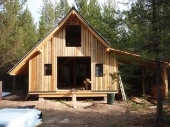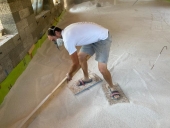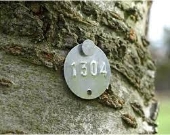So cuttings is low likelihood. BUT you probably have some ROOTS left in ground... in fact the perfect size HL are probably rooting right now for coming year.
Cordon off the area as far out as you can and do not mow. Wait for little trees to come up. Dig and move them. then mow.
If you want to do cuttings or clone I recall they are misting them every 10 mins for weeks or months or something with a willow water/ or that grafting stuff spray and kelp (from memory.)
Is your soil / climate better for BL or HL?
"HL-
Mid Atlantic South
Looks good warmer climate
Better drain soils in warmer sites
BL- better in cooler and clay soil"
Edible Acres sells
Root propagation of Ship Mast Black Locust. Straight Tall. *** Get Some ***
Twisted Tree too
Video of said process... for BL but it's confirmed for HL
https://www.youtube.com/watch?v=igTc15F0jjY
Plant
Cuttings Root Segments
2-4” long
pencil thin best
Dirt pruners
2-4” apart
Close canopy for plants
Top just barely covered
Fluff the soil
2-5’ tall plants by fall
Root direction important up
Or lay flat
Need to move quickly roots don't like sun or being out of ground.
Sitting out of ground they lose vigor.
Red light room for Cuttings ?
4x4 bed = 100 Plants
Very tight spacing
Un-mulched soil can warm
Late spring NY (central)
Not March April
May NY
Perlite loose
4 years to bark hardens to allow sheep near trunk
"Vegetative Reproduction- Honeylocust coppices freely. Propagation, particularly of high quality clonal stock, can be achieved by grafting, budding, and cuttings from hardwood, softwood, and roots (7). Root cuttings appear to be the best method of reproducing desirable strains in large quantities at reasonable cost. At times other species or varieties are grafted onto the rootstock of honeylocust (24)."
USDA
https://www.srs.fs.usda.gov/pubs/misc/ag_654/volume_2/gleditsia/triacanthos.htm#:~:text=Vegetative%20Reproduction%2D%20Honeylocust%20coppices%20freely,large%20quantities%20at%20reasonable%20cost.
Or you can just order them.
China and Hungary seem to have best genetics BL without thorns.. maybe HL too. My research is 3 years out of date
Virgina Tech is the go to HL
What type of soil do you have... I have a several posts on this in here.
Honey Locusts
Virginia tech research
Mid Atlantic South
Looks good warmer climate
Better drain soils in warmer sites
BL better in cooler and clay soil
Millwood
Pod heavy
Train molasses
BL + HL Varieties
Locusts are fast-growing, hardy trees that belong to the pea family Fabaceae or Leguminosae. Most of the locust species are classified into two genera –
Gleditsia and Robinia. While the genus Gleditsia has 12 species, there are around ten species in the genus Robinia. The most popular among them are Robinia pseudoacacia (black locust) and Gleditsia triacanthos (honey locust). Both are deciduous, and are grown as landscape trees. You may also come across different locust cultivars.
Some of the more famous cultivars include Decaisneana, Frisia, Purple robe, Tortuosa, Unifoliola.
Decaisneana Is a hybrid of two different Robinia species, it is distinguished by its small forms and rose pink flowers. Frisia has bright red thorns/prickles and bright yellow-green leaves. It’s striking colors make it a popular ornamental tree. Tortuosa is a cultivar known for its curved and warped looking branches. Unifoliola is shorter than other varieties of locust tree, and it also possesses no spines. The purple robe tree gets its name from its purplish pink flowers. Like Frisia, purple robe has red prickles. The tree’s flowers often stay blooming for longer than other varieties of black locust.
Even the carob tree (Ceratonia siliqua) and the African locust bean tree (Parkia biglobosa) are called locust trees. They too belong to the family Fabaceae. Though there are more than 20 species of locust trees, two species are very popular. They are black locust and honey locust trees. Here is a brief overview about some of the characteristic features of these trees.
HL
VTech ‘Sunburst’ honey locust
Thornless Honey Locust (Gleditsia triacanthos var. inermis) Thornless Honey Locusts are resilient and adaptable, thriving in various soil types and weather conditions
Sunburst Honey Locust (Gleditsia triacanthos var. inermis ‘Sunburst’) Sunburst Honey Locusts are relatively low-maintenance, thriving in full sun and well-drained soils.
Shademaster Honey Locust(Gleditsia triacanthos var. inermis ‘Shademaster’)
various soil conditions make them a top choice for landscapers and arborists
Skyline Honey Locust (Gleditsia triacanthos var. inermis ‘Skycole’).
upright, columnar growth habit. This unique shape makes it an ideal choice for narrow spaces or along driveways and streets, where a tall, slender tree is desired. Skyline Honey Locusts feature bright green compound leaves that create a dense canopy, offering a pleasant shade during the warmer months. These trees are hardy and adaptable, thriving in various soil types and weather conditions.
Moraine Thornless Honey-Locust (Gleditsia triacanthos f. inermis ‘Moraine’)
resilience, adapting well to various soil types and weather conditions.
Imperial™ Thornless Honey-Locust (Gleditsia triacanthos f. inermis ‘Impcole’)
The Imperial™ Thornless Honey-Locust, scientifically referred to as Gleditsia triacanthos f. inermis ‘Impcole,’ is a cultivar renowned for its thornless branches. This variety stands out for its vibrant golden-yellow foliage, making it a visually striking choice for ornamental landscapes. Its leaves showcase a stunning display of bright colors, adding warmth and visual interest to gardens and public spaces. Thriving in full sun and well-drained soils, Imperial™ Thornless Honey-Locusts are relatively low-maintenance, making them a popular selection for enhancing outdoor aesthetics.
Northern Acclaim Thornless Honey-Locust (Gleditsia triacanthos f. inermis ‘Harve’)
The Northern Acclaim Thornless Honey-Locust, scientifically known as Gleditsia triacanthos f. inermis ‘Harve,’ is valued for its thornless nature and graceful appearance. This cultivar is admired for its ability to provide ample shade, making it a preferred choice for parks, streets, and residential areas. Its fern-like leaves turn a vibrant yellow in the fall, creating a picturesque autumnal display. Northern Acclaim Thornless Honey-Locusts are drought-tolerant and adaptable,
BL
Decaisneana, Frisia, Purple robe, Tortuosa, Unifoliola. Decaisneana Is a hybrid of two different Robinia species, it is distinguished by its small forms and rose pink flowers. Frisia has bright red thorns/prickles and bright yellow-green leaves.
Tortuosa is a cultivar known for its curved and warped looking branches. Unifoliola is shorter than other varieties of locust tree, and it also possesses no spines. The purple robe tree gets its name from its purplish pink flowers. Like Frisia, purple robe has red prickles. The tree’s flowers often stay blooming for longer than other varieties of black locust.
Selected cultivars:
‘Frisia' - This tough tree is drought-tolerant and has an oval form with upright arching branches. Summer foliage is bright yellow, then turns golden yellow in fall. Flowers are white.
‘Inermis' - A thornless cultivar, this tree is small (20 feet tall) and globe-shaped.
‘Purple Robe' - This compact, rounded cultivar, one of the most attractive forms, should not exceed 30 to 40 feet in height. It has lovely, dark rose-pink flowers. New growth is bronzy red. It is short-lived and prone to borer injury.
‘Pyramidalis' (‘Fastigiata') - This upright, columnar cultivar will tolerate poor soils. It is spineless. Its shape is similar to Lombardy poplar, as it reaches a height of 40 feet with a width of 15 feet. Foliage is medium green in summer and yellow in fall. Flowers are white and in clusters.
‘Tortuosa' - This small cultivar has contorted branches.
‘Umbraculifera' - An interesting cultivar that forms an flat, umbrella-like top. Although uncommon in the U.S., it is a common landscape and street tree in Northern European gardens.
'Nyirségi' Black Locust
Twisty Baby: A cultivar of black locust.
Robinia pseudoacacia
Origin: Hungary
Improvement status: Cultivar
Seeds per packet: ~25
BOTANICAL SAMPLE - NOT GERMINATION TESTED
Life cycle: Perennial
A common tree in much of the US today, the original range of black locust is thought to be the Eastern Appalachian mountains and the Ozarks. Black locust is a thorny, suckering tree that will generally keep coming back after being chopped to the ground. Like many native trees, black locust is a pollinator magnet and provides lots of nectar for honeybees. It’s long been used by farmers and homesteaders for building, fencing, and firewood, because it's one of the most durable, rot-resistant native hardwoods (surpassed by Osage orange and little else). It also burns as hot as coal.
Black locust recently gained traction among agroforestry practitioners as a coppice species providing animal forage and nitrogen cycling services. A truly versatile plant, its aromatic cream-colored flowers are delicious batter dipped and fried. They also make a great springtime iced or hot tea. The seed pods contain a tangy, sweet paste, like a North American version of tamarind.
'Nyirségi' is a cold hardy (Zone 5) Hungarian forestry selection with a straight and tall growth habit, making it ideal for various timber uses. Our seed was imported from Hungary by the good folks at Sheffield's Seed Company in Locke, NY.
GROWING TIPS: No cold stratification required, but scarification greatly helps germination rate. Soak seeds in hot water for 24hrs before planting time, letting them swell to 3x their original size (if this fails, try boiling water or sulfuric acid). Or fall seed to let the winter weather break down the seed coating. Sow seed 1/4" deep. Trees can reach 80 feet. Prefers full sun and dry to medium soil. Flowers May-June.
NOTE: Photos do not necessarily depict the 'Nyirségi' variety (but the image of the row of trees is similar). All images are in the public domain, except the one of our dear friend and board member Sally McCabe, which was taken by Nate.
Hungary is currently the leading European country in black locust genetic improvement programmes ([77], [41], [1], [2]). On the other hand, significant breeding activity has also emerged in China, which has developed over 100 newly-bred black locust cultivars
https://iforest.sisef.org/contents/?id=ifor4254-016
Purple Robe Locust
Mature size and shape: Medium to large. 30 to 50 feet high x 20 to 35 feet wide. Upright and rather irregular shape. Relatively oval overall. Upright tree with a straight trunk and a narrow oblong crown, becoming ragged and scraggly with age.
In the Republic of Korea black locust leaves are used for forage. Pulverized leaves, at a 30 percent ratio, are mixed into rice bran as forage for pigs. In chicken feed, they can replace alfalfa. For this purpose a tetraploid black locust, the clone Robinia pseudoacacia 'Gigas', is used, having leaves three times bigger and with 1.4 times more protein content than normal diploid black locusts."
Then, if you want to be even more confused, see this info at Plants for a Future:
http://www.pfaf.org/database/plants.php?Robinia+pseudoacacia
So...... Is toxicity determined by amount of ingestion?
It's a puzzlement.





...


